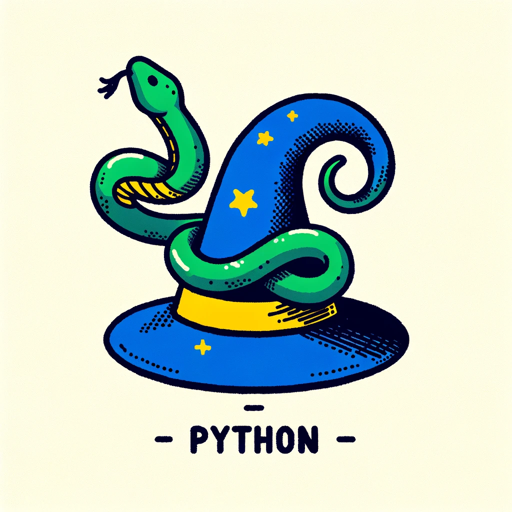TKinter UI v2.1-advanced GUI toolkit
AI-powered graphical user interface design
How can I code a login window in Tkinter?
What's the best way to combine these Tkinter UI elements?
Can you help optimize my Tkinter UI code?
How do I add a new feature to my existing Tkinter UI?
How do I combine multiple Tkinter UIs into one UI.
Related Tools
Load MoreMatPlotLib Assistant
Maintained by Whitebox at https://github.com/Decron/Whitebox

IOS
Upload a screenshot or image and turn it into iOS code.

Python Code Expert
Develop Python applications that are efficient, maintainable, testable, performant, and robust. Excels at OOP design, error handling, documentation, logging, and much more. Includes unit tests written in pytest for all code snippets.
Python Tutor
Guides in Python with examples

Python | Code Wizard v.2
Improved Python code analysis and execution power.

Python GUI App Builder
Assists non-coders with complete Python GUI app code snippets.
20.0 / 5 (200 votes)
Introduction to TKinter UI v2.1
TKinter UI v2.1 is a specialized Python module designed to facilitate the creation of graphical user interfaces (GUIs) using the Tkinter library. It is built to support the integration of multiple UI elements into cohesive, functional interfaces, particularly suited for applications that require robust user interaction and data management. The design purpose of TKinter UI v2.1 is to streamline the development process for complex interfaces by providing comprehensive examples and step-by-step instructions, ensuring the solutions are both accessible and effective. For example, it helps users avoid common errors in UI integration by leveraging techniques such as validation, automation, and modular design.

Main Functions of TKinter UI v2.1
Widget Integration
Example
Combining Entry, Button, and Label widgets to create a data entry form.
Scenario
A data entry application where users need to input, validate, and submit information efficiently.
Event Handling
Example
Binding button clicks to specific functions that process user input.
Scenario
A simple calculator application where pressing a button triggers a calculation and displays the result.
Layout Management
Example
Using grid and pack geometry managers to arrange widgets within the window.
Scenario
A dashboard application displaying various metrics and controls in a well-organized manner.
Ideal Users of TKinter UI v2.1
Beginner Python Programmers
Individuals who have learned the basics of Python and want to start designing powerful GUI applications. They benefit from the structured approach and detailed examples that help them transition from writing simple scripts to developing more complex applications.
Data Analysts and Scientists
Professionals who need to build data entry and visualization tools. TKinter UI v2.1 offers them the ability to create custom interfaces that streamline data collection and analysis, integrating seamlessly with other Python data processing libraries.

Guidelines for Using TKinter UI v2.1
Step 1
Visit aichatonline.org for a free trial without login, also no need for ChatGPT Plus.
Step 2
Ensure you have Python 3.x installed on your system along with the Tkinter library. This setup is essential for developing and running TKinter UI applications.
Step 3
Familiarize yourself with the basic widgets and layout management techniques of Tkinter by exploring the official Tkinter documentation or relevant tutorials.
Step 4
Utilize TKinter UI v2.1 to design and integrate various UI components, ensuring you follow best practices for creating responsive and user-friendly interfaces.
Step 5
Test your application thoroughly, addressing any bugs or usability issues to enhance the overall user experience. Regular updates and maintenance will help keep the application functional and efficient.
Try other advanced and practical GPTs
Calendar
Smart scheduling with AI assistance

LaShootingBOX
AI-powered solutions for content and creativity

Legal Advisor
AI-Powered Legal Guidance Simplified

Etsy Business Growth Expert
AI-powered Etsy shop growth expert.

Stories for Jira Backlog
Streamline your Jira backlog with AI.

AicademiQ
AI-enhanced research and study support

Orion Script Creator
AI-powered scripting for Ultima Online.

Crypto and Stock Analyst Pro Max 20.0
AI-powered insights for smart investing.

PsychoGPT
Unleash Creativity with AI Power

2D Game Art Creator
AI-powered 2D game art creation.

Dungeon Goblin's Fantasy Character Creator
AI-powered character creation for dark fantasy worlds

20 Minuten - Nachrichten (BETA)
AI-powered Swiss news insights

- Automation
- Educational
- Data Entry
- Dashboards
- Games
Common Questions and Answers about TKinter UI v2.1
What is TKinter UI v2.1?
TKinter UI v2.1 is an advanced toolkit for creating graphical user interfaces in Python. It combines multiple UI elements into cohesive interfaces, enabling developers to build robust and responsive applications.
What are the prerequisites for using TKinter UI v2.1?
You need Python 3.x and the Tkinter library installed on your system. Basic knowledge of Python programming and understanding of Tkinter widgets will be beneficial.
What common use cases does TKinter UI v2.1 support?
TKinter UI v2.1 is ideal for developing data entry forms, dashboards, educational tools, simple games, and automation tools. Its flexibility allows it to be used in a wide range of applications.
How can I optimize my Tkinter application for performance?
Ensure efficient event handling, minimize the use of global variables, and keep the UI responsive by avoiding long-running tasks in the main thread. Utilize threading or asynchronous programming to handle such tasks.
What are some tips for designing user-friendly interfaces with TKinter UI v2.1?
Focus on simplicity and clarity, ensure consistent styling, provide clear feedback for user actions, and test the interface with actual users to gather feedback and make improvements.